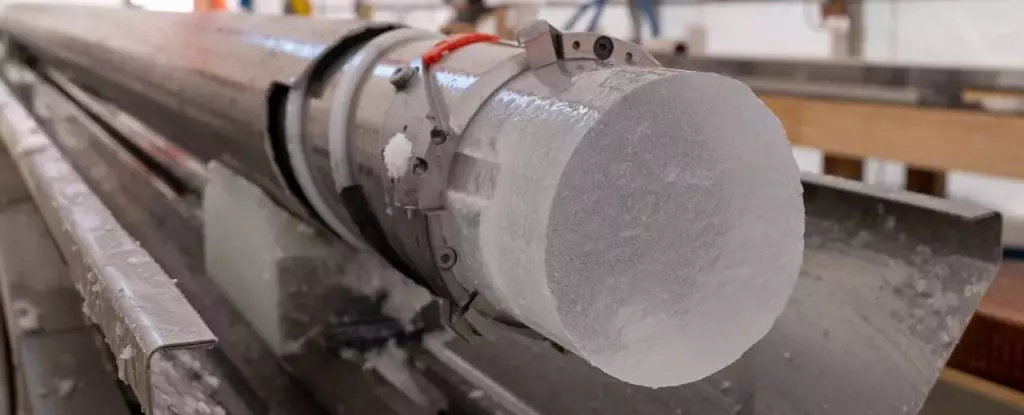The recent advancements in Antarctic ice core drilling present a groundbreaking opportunity for scientists to explore Earth’s climate history. A newly drilled ice core, measuring an astounding 2,800 meters (over 9,186 feet), is believed to house an untouched record of climate patterns extending back as far as 1.2 million years. This vital sample, obtained from East Antarctica, could serve as a compelling narrative of our planet’s climatic past, offering invaluable insights into the Earth’s fluctuating environments, greenhouse gas concentrations, and the extreme conditions that have at times threatened the survival of human species.
Ice cores are unique geological artifacts that encapsulate atmospheric samples from epochs long past. The intricate layering of ice, similar to tree rings, provides chronological markers that scientists can analyze for various indicators of climate health. Each meter of this newly acquired core potentially represents up to 13,000 years of atmospheric data, preserved in microscopic air bubbles and isotopic compositions. Through these records, researchers can examine how ancient atmospheres shifted alongside Earth’s climate and assess the influence of natural and anthropogenic factors on these variations.
The researchers involved in this colossal endeavor, particularly those from the European Project for Ice Coring in Antarctica (EPICA), have emphasized the significance of reconstructing Earth’s climate history in light of current climatic disruptions. As the chief scientist Julien Westhoff noted, the uppermost sections of the ice core contain a critical timeline of events spanning back to 1.2 million years prior—fortifying our understanding of the ecological transitions that have occurred over eons.
The timeline revealed by these ice cores is especially relevant during a period when human-induced climate change has incited widespread alarm. Past cycles of glaciation demonstrate how the planet has repeatedly oscillated between warm interglacial periods and colder glacial epochs through natural processes. The newly extracted ice can shed substantial light on a particularly enigmatic change that occurred between approximately 900,000 and 1.2 million years ago when the patterns of glacial cycles lengthened dramatically. This changes the narrative, suggesting intriguing relationships between greenhouse gas concentrations, climate stability, and ancient biodiversity.
One hypothesis posited by some scientists indicates that these intense fluctuations may have contributed to a significant decline in early human populations in Africa, a theory that remains contentious and merits further investigation. By obtaining an unbroken ice core stretching back so far in time, researchers aim to evaluate if there is a correlation between atmospheric conditions and human survival during these tumultuous periods.
The drilling site at Little Dome C was methodically chosen based on extensive radar surveys that indicated it possessed thick layers of pristine ice—critical for yield high-quality samples. Situated 3,200 meters above sea level, Little Dome C poses significant challenges including harsh temperatures averaging around -35°C (-31°F) during the summer months and relentless wind conditions. The logistical efforts required to establish the drilling infrastructure were monumental, taking about 20 days to transport necessary materials from the nearest research facilities.
The advanced isotopic analysis systems put in place allow for real-time readings of the extracted core sections, significantly enhancing the efficiency and accuracy of climate reconstructions. This immediacy in data analysis enables scientists to stay abreast of their findings and leverage newfound knowledge into ongoing climate conversations, fortifying the urgency of addressing contemporary climate issues.
The potential implications of this ice core research cannot be overstated. Climate experts, such as Richard Alley, foresee transformative insights arising from this drilling effort that could reshape our understanding of Earth’s climatic past and inform more sustainable future practices. If the data from the new cores effectively illuminates the complex interplay between greenhouse gases and temperature over vast periods, it will drastically enhance our comprehension of the natural cycles of climate, paving the way for more informed policy decisions in mitigating current anthropogenic impacts.
The ongoing investigations into Antarctica’s ancient ice cores promise to provide not only distinct insights into the planet’s climate history but also hold profound implications for our future. By unraveling the mysteries locked within the ice, we not only seek to understand our planet’s past but also forge a pathway toward a more sustainable coexistence with nature. The essential narrative of our climate history lies ahead, and it beckons us to listen and learn for generations to come.

Leave a Reply